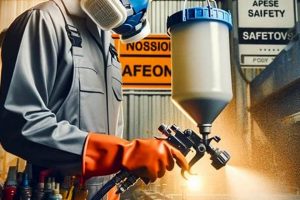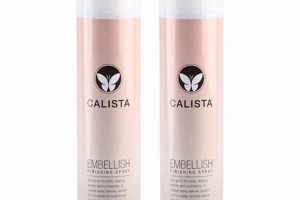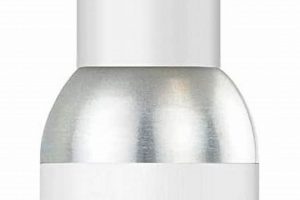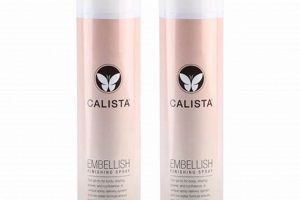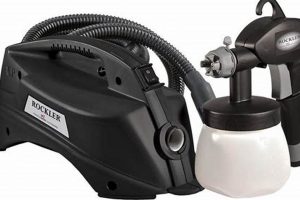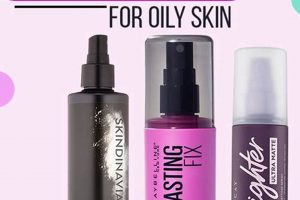A liquid coating applied as the final step in a manufacturing or refinishing process, it imparts desired properties such as gloss, protection, and color to a substrate. For instance, a clear coat applied to a newly painted car protects the underlying color from UV damage and enhances its shine.
This final layer is crucial for extending the lifespan of the coated object by providing a barrier against environmental factors like moisture, abrasion, and chemical exposure. Historically, its application was primarily manual, but advancements in technology have led to automated processes, increasing efficiency and consistency in production settings.
The subsequent discussion will delve into the different types available, their respective applications across various industries, and factors to consider when selecting the appropriate one for a specific project.
Application Strategies for Optimal Results
Achieving a professional quality requires careful planning and execution. The following guidelines provide insights into best practices for consistent and durable results.
Tip 1: Surface Preparation is Paramount: Ensure the substrate is clean, dry, and free from contaminants. Residue such as grease, dust, or loose particles will impede adhesion and compromise the aesthetic outcome. A thorough cleaning, sanding, and priming process will significantly improve the final product.
Tip 2: Maintain Consistent Distance and Speed: Proper application technique involves maintaining a consistent distance between the nozzle and the object. Varying distances and speeds can result in uneven coverage, runs, or orange peel texture. Practice on scrap material to develop a smooth, consistent motion.
Tip 3: Control Ambient Conditions: Temperature and humidity significantly impact drying time and finish quality. Excessively humid conditions can lead to blushing or clouding, while extreme temperatures can cause the coating to dry too quickly or too slowly. Refer to the manufacturer’s specifications for optimal environmental parameters.
Tip 4: Multiple Thin Coats are Preferable: Applying several thin coats, allowing each to dry adequately, yields a more uniform and durable layer than a single heavy coat. Thick applications are prone to runs, sags, and solvent entrapment, which can weaken the coating’s integrity.
Tip 5: Utilize Proper Equipment and Nozzle Settings: The selection of the appropriate spray gun and nozzle size is crucial for atomization and material flow. Different materials require specific nozzle configurations to achieve optimal spray patterns and minimize waste. Consult the equipment manufacturer’s recommendations.
Tip 6: Overlap Each Pass: To ensure uniform coverage, overlap each spray pass by approximately 50%. This technique prevents streaking and ensures consistent film thickness across the entire surface.
Tip 7: Apply in a Well-Ventilated Area: Adequate ventilation is essential for dissipating fumes and preventing the accumulation of flammable vapors. Work in a well-ventilated space or utilize a spray booth with appropriate exhaust systems to maintain a safe working environment.
By adhering to these recommendations, one can enhance the appearance and longevity of the coated object, minimizing imperfections and maximizing protection against environmental factors.
The subsequent section will address common issues encountered during application and provide troubleshooting solutions.
1. Surface Preparation
The efficacy and longevity of a final coating are inextricably linked to the quality of surface preparation. This foundational stage directly influences adhesion, appearance, and the protective properties of the applied material. The presence of contaminants, such as oils, dust, or existing coatings, creates a barrier preventing the proper bonding of the finishing material to the substrate. For instance, if a metal surface is not properly degreased before the application of a protective coating, corrosion may occur beneath the coating, leading to premature failure. Similarly, inadequate sanding of a wood surface results in an uneven application, compromising the aesthetic quality and durability of the coating.
Consider the automotive industry, where meticulous surface preparation is essential for achieving a flawless automotive paint finish. The process typically involves removing any existing paint, repairing imperfections, and applying a primer to create a uniform base. Failure to properly prepare the surface can lead to issues such as paint peeling, bubbling, or inconsistencies in color and gloss. In industrial applications, such as pipeline coating, surface preparation often involves abrasive blasting to remove rust and scale, creating a profile that enhances adhesion and prevents corrosion. In these cases, not taking enough time with surface preparation may save time up front, but in the long run costs the project time, money, and resources to correct the application.
In conclusion, surface preparation is not merely a preliminary step but an integral component that determines the ultimate success of the final layer. Neglecting this aspect will inevitably result in diminished performance, increased maintenance costs, and reduced lifespan of the coated object. Therefore, a comprehensive understanding of surface preparation techniques and their impact on coating performance is crucial for achieving optimal results across various industries and applications.
2. Application Technique
The method employed to apply the liquid coating significantly influences its ultimate performance and aesthetic characteristics. Suboptimal execution can negate the benefits of even the highest-quality materials.
- Atomization Quality
The process of breaking down the liquid into fine particles is critical. Insufficient atomization results in larger droplets that can lead to uneven coverage, runs, and sags. Conversely, excessive atomization can cause premature drying and overspray, leading to a rough texture. Proper equipment selection and adjustment are paramount to achieving optimal atomization.
- Distance and Angle Control
Maintaining a consistent distance and angle between the application device and the surface is crucial for uniform film thickness. Variations in distance and angle lead to inconsistencies in coating thickness and appearance. For example, applying the material too close may result in excessive buildup and runs, while applying it too far can lead to dry spray and poor adhesion. Industrial painting robots are programmed to control these parameters precisely.
- Overlap Consistency
Overlapping each pass by the appropriate amount ensures complete coverage and prevents streaking or voids. Insufficient overlap can result in thin spots and inconsistent color, while excessive overlap can lead to excessive film build and potential cracking. The optimal overlap percentage varies depending on the material and equipment used.
- Environmental Awareness
Ambient conditions, such as temperature, humidity, and airflow, impact the drying and curing process. High humidity can lead to blushing or clouding, while extreme temperatures can affect viscosity and flow. Controlling these factors through proper ventilation and temperature regulation is essential for achieving a satisfactory outcome. For instance, applying coatings in a climate-controlled spray booth mitigates the adverse effects of fluctuating environmental conditions.
In summary, mastery of application technique is essential for realizing the full potential of any concluding material. Consistent control of atomization, distance, overlap, and environmental factors directly translates to improved aesthetics, durability, and protection of the coated object.
3. Material Selection
The choice of coating material is intrinsically linked to the success of any finishing application. Material properties dictate the final appearance, durability, and protective characteristics of the treated surface. The intended use of the coated object, the environmental conditions it will face, and the substrate material are all crucial considerations in the selection process. Using an inappropriate material can result in premature failure, aesthetic defects, and increased maintenance costs. For example, a water-based acrylic coating, while environmentally friendly and suitable for interior applications, would be inadequate for protecting exterior metal surfaces from corrosion. Similarly, a high-solids epoxy coating, known for its chemical resistance, might be overkill for a decorative wood project where a simpler varnish would suffice.
The compatibility of the material with the substrate is paramount. Some substrates, such as certain plastics, may be sensitive to the solvents present in specific coatings, leading to damage or degradation. Likewise, the flexibility and expansion/contraction properties of the coating must align with those of the substrate to prevent cracking or peeling due to thermal cycling or mechanical stress. The selection process should also consider the required performance characteristics, such as abrasion resistance, UV resistance, chemical resistance, and gloss level. A coating intended for use on a high-traffic floor will require significantly higher abrasion resistance than one used on a decorative trim. Selecting the correct raw material ensures performance of product and longevity as well.
In conclusion, the careful consideration of factors such as substrate compatibility, environmental exposure, and desired performance characteristics is paramount for successful implementation. Selecting the most appropriate material is key to achieving the desired appearance, durability, and protective properties, ultimately maximizing the value and lifespan of the coated object and can increase efficiency by reducing re-works due to incorrect material selection.
4. Environmental Conditions
Ambient atmospheric factors exert a considerable influence on the outcome of any coating application. Temperature, humidity, and air movement directly affect the viscosity, drying rate, and ultimate integrity of the film. Deviations from recommended environmental parameters can lead to a range of defects, compromising both the aesthetic appeal and the protective function of the coating. High humidity, for example, can cause moisture to become trapped within the coating layer, resulting in blushing or clouding. Conversely, excessively high temperatures can accelerate the drying process, leading to poor flow and leveling, resulting in an “orange peel” texture. Air movement, if uncontrolled, can introduce contaminants and cause uneven drying.
The practical significance of understanding environmental influences is evident in various industries. In automotive refinishing, climate-controlled spray booths are employed to regulate temperature, humidity, and airflow, ensuring consistent and high-quality results. Similarly, in aerospace manufacturing, precise environmental control is critical for applying specialized coatings that protect aircraft components from corrosion and extreme temperatures. Bridge painting operations are often scheduled to coincide with favorable weather conditions, minimizing the risk of coating failure due to moisture or extreme temperatures. The presence of direct sunlight should also be considered, as the heat generated can also impact coating properties while the product is still wet.
In summary, careful monitoring and management of environmental conditions are indispensable for achieving optimal results during the spray application process. Neglecting these factors can lead to a range of costly defects and compromise the long-term performance of the coating. Therefore, proper planning and investment in environmental control measures are essential for ensuring the quality and durability of applied layers across diverse industries.
5. Equipment Calibration
Precise equipment calibration is a critical determinant of quality. Variations in equipment settings directly impact atomization, flow rate, and spray pattern, consequently affecting the appearance, durability, and protective characteristics of a final coating.
- Fluid Delivery Accuracy
Accurate calibration ensures the consistent delivery of coating material. Deviations in fluid output can lead to variations in film thickness, resulting in inconsistencies in color, gloss, and protection. For instance, an incorrectly calibrated pump in an automated system may deliver insufficient material, leading to a thin, unprotected layer, or excessive material, resulting in runs and sags.
- Air Pressure Regulation
Precise air pressure control is essential for optimal atomization. Fluctuations in air pressure can affect the particle size of the coating material, leading to uneven distribution and a rough texture. For example, insufficient air pressure may result in larger droplets and a coarse surface, while excessive pressure can cause the coating to dry too quickly, leading to a powdery finish.
- Spray Pattern Consistency
Proper calibration ensures a uniform spray pattern, which is critical for consistent coverage and minimal material waste. Inconsistent spray patterns can lead to streaking, uneven color distribution, and variations in film thickness. For example, a clogged nozzle or misaligned air cap can disrupt the spray pattern, resulting in a flawed and unprofessional result.
- Equipment Maintenance Schedules
Regular maintenance, as part of calibration, helps prevent deviations from expected performance. Implementing routine equipment inspections and adhering to manufacturer-specified maintenance protocols ensures consistent results. For instance, regular cleaning of nozzles and filters prevents clogs that can lead to uneven spray patterns, and replacing worn components helps maintain consistent fluid delivery.
The combined effect of these elements demonstrates that properly calibrated and maintained equipment directly contributes to the attainment of a uniform, durable, and aesthetically pleasing final surface. Consistent equipment care decreases waste, rework, and overall project costs, proving that equipment calibration is a critical element within the process.
6. Drying Process
The drying process represents a critical phase in the application, significantly impacting the final characteristics and performance of the coated surface. It is the transition during which the liquid coating transforms into a solid film, and any deviation from optimal conditions can result in defects that compromise the integrity of the coating. The rate and uniformity of drying directly influence properties such as gloss, hardness, adhesion, and resistance to environmental factors. Inadequate drying can lead to solvent entrapment, resulting in a soft or tacky finish that is susceptible to damage. Conversely, excessively rapid drying can cause cracking, blistering, or poor adhesion. An example is a clear coat on a vehicle which, when dried incorrectly, will result in the vehicle needing to be recoated.
Different types of materials necessitate specific drying parameters. Solvent-based coatings typically dry through evaporation of the solvent, while water-based coatings rely on both evaporation and film formation through coalescence of the polymer particles. Two-component coatings, such as epoxies and polyurethanes, cure through a chemical reaction between the resin and hardener. The drying or curing time is heavily influenced by ambient temperature, humidity, and airflow. For instance, high humidity can impede the evaporation of water from water-based coatings, extending the drying time and potentially leading to defects. Forced-air drying or heat curing may be employed to accelerate the drying process and achieve desired properties in a timely manner. Industrial ovens are used to achieve this.
In conclusion, a thorough understanding and careful control of the drying process are essential for achieving optimal results. Improper drying can negate the benefits of even the highest-quality materials and skilled application techniques. Therefore, strict adherence to manufacturer’s recommendations and close monitoring of environmental conditions are crucial for ensuring a durable and aesthetically pleasing result. This often necessitates a controlled environment such as a spray booth.
7. Curing Parameters
Curing parameters are intrinsically linked to the final characteristics of the application, dictating the transformation from a liquid or semi-solid state to a durable, functional film. Curing, unlike simple drying which primarily involves solvent evaporation, is a chemical process where cross-linking occurs within the coating, leading to increased hardness, chemical resistance, and adhesion. Deviations from specified temperature, humidity, and time during this curing phase directly influence the degree of cross-linking, resulting in under-cured or over-cured applications. An under-cured surface may exhibit softness, tackiness, and poor resistance to solvents and abrasion, while an over-cured surface may become brittle and prone to cracking.
For example, in the automotive industry, coatings require precise temperature control to achieve the desired hardness and gloss. Insufficient baking temperatures or curing times can compromise the coating’s resistance to scratches and environmental damage. Similarly, in the aerospace sector, certain epoxy-based applications require carefully controlled elevated temperatures for extended periods to ensure optimal cross-linking and the attainment of specified mechanical properties. In the construction industry, concrete sealers must cure properly, or they won’t protect the concrete surface from chemicals and wear.
Therefore, a thorough understanding and meticulous adherence to recommended curing parameters are crucial for realizing the full potential of the final coating. Accurate control of temperature, humidity, and curing time ensures that the coating achieves its intended performance characteristics, providing long-lasting protection and aesthetic appeal. Neglecting this aspect can lead to premature failure of the coating, requiring costly repairs and rework. Accurate equipment and monitoring of the entire process is essential for long term quality and lower cost due to fewer re-applications.
Frequently Asked Questions
This section addresses common inquiries regarding application, aiming to clarify key aspects and provide practical guidance.
Question 1: What factors contribute to the formation of “orange peel” texture during the application process?
Several factors can lead to the development of this surface defect, including improper atomization, incorrect air pressure, excessively high viscosity, and rapid solvent evaporation. Mitigation strategies involve adjusting equipment settings, thinning the material as recommended, and controlling ambient temperature to slow the drying rate.
Question 2: How does substrate preparation influence the adhesion and longevity of the applied layer?
Substrate preparation is paramount for achieving optimal adhesion. Contaminants such as grease, oil, and rust must be removed to ensure direct contact between the coating and the substrate. Proper surface profiling, through methods like sanding or abrasive blasting, increases the surface area for mechanical bonding, enhancing long-term durability.
Question 3: What are the key considerations for selecting the appropriate nozzle size and spray pattern?
The selection of nozzle size and spray pattern depends on the material’s viscosity, the size and shape of the object, and the desired application speed. Larger nozzles are suitable for high-viscosity materials and large surfaces, while smaller nozzles provide finer atomization for intricate details. Overlapping spray patterns ensure uniform coverage and minimize the risk of streaking.
Question 4: How does humidity affect the final finish?
High humidity can impede the evaporation of solvents from the layer, leading to blushing, clouding, or a soft, tacky finish. Maintaining optimal humidity levels, as specified by the manufacturer, is crucial for achieving a durable and aesthetically pleasing result. In some cases, adding a retarder to the layer can slow the drying rate and prevent moisture entrapment.
Question 5: What steps should be taken to prevent runs and sags during application?
Runs and sags typically occur when the is applied too thickly or when the viscosity is too low. Applying multiple thin coats, allowing each to dry adequately, prevents excessive material buildup. Adjusting equipment settings to reduce the fluid output and increasing the material’s viscosity can also mitigate these defects.
Question 6: Is ventilation important?
Adequate ventilation is essential for dissipating fumes and ensuring a safe working environment. Insufficient ventilation can lead to the accumulation of hazardous vapors, posing health risks. Moreover, proper ventilation promotes uniform drying and prevents the introduction of contaminants onto the freshly applied layer.
Proper planning and execution are fundamental to the success of any process. Addressing these common questions and implementing best practices will improve the quality and durability of the final layer.
The following section will explore specific applications across diverse industries.
Conclusion
This exploration has underscored the critical role plays in achieving desired aesthetic and functional properties. From surface preparation and material selection to application techniques and environmental control, each factor significantly influences the final outcome. The necessity for precision and adherence to established best practices has been consistently emphasized. Moreover, the impact of curing parameters and the drying process on film integrity were explored, further highlighting the complexity of achieving optimal results.
The information presented serves as a resource for informed decision-making and process optimization within industries reliant on surface finishing. Recognizing the multifaceted nature of the application process encourages a commitment to continuous improvement and adaptation to evolving technologies and environmental considerations. Understanding and implementing these principles will undoubtedly contribute to enhanced product quality, durability, and overall performance.


